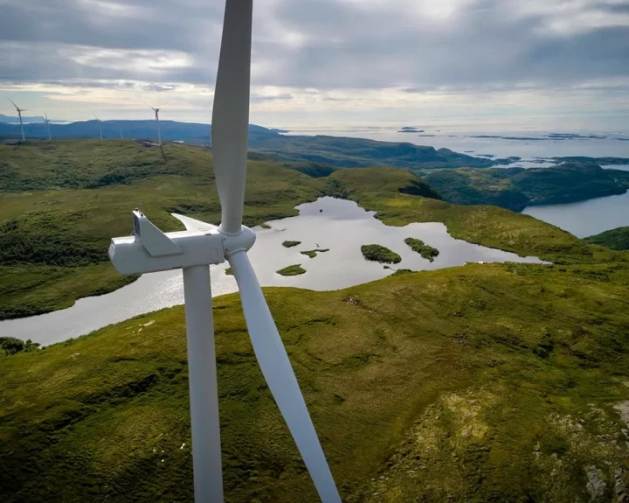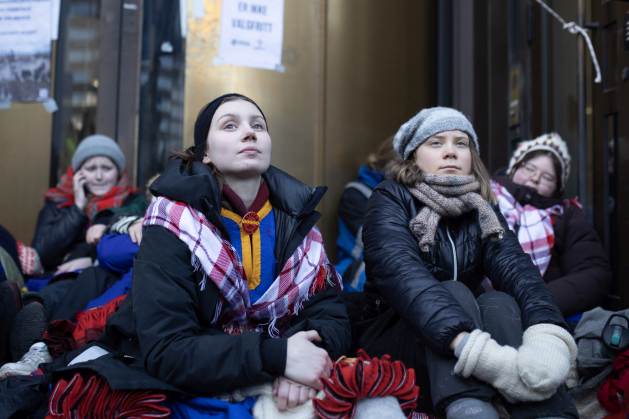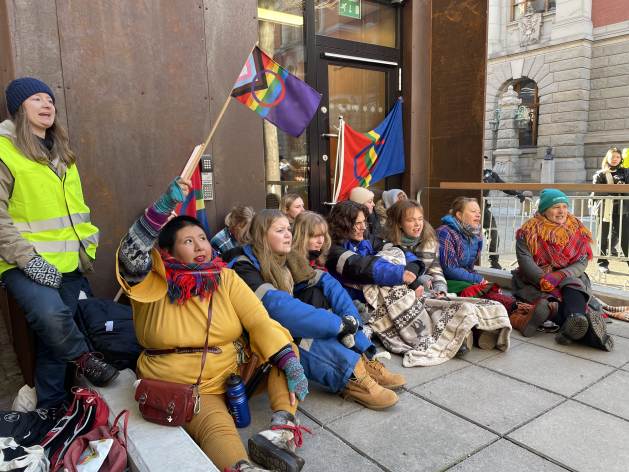The Sami People's Fight Against Norwegian Windmills

ROME, Mar 09 (IPS) - There are 151 wind turbines and more than 130 kilometres of connection routes and power lines on the Fosen peninsula, 530 kilometres north of Oslo. Norwegian judges say that they should not be there, and the owners of those lands since time immemorial do too.
But it is not a mirage.
“The wind farm crisscrosses areas of winter pasture that can no longer be used because the reindeer will never come near the windmills. Thus, an ancestral migration route that is crucial for us has been destroyed,” says Maria Puenchir, a 31-year-old human rights activist who is well-known in the region, and presents herself as "queer, Sami and disabled", told IPS over the phone.
The Sami, also known as Lapps or Saami, are a people spread across the northern borders of Norway, Sweden, Finland and Russia, in a territory they call Sápmi.
Puenchir spoke from her native Trondheim, very close to the peninsula where the wind complex stands today under scrutiny. Its construction began in 2016 despite numerous calls for its suspension, including one from the United Nations, citing its potential impact on the way of life of local communities.
Five years later and one after its completion, the Norwegian Supreme Court ruled unanimously among its eleven judges that the installation was illegal and violated the rights of reindeer herders to develop their culture.
“The ruling is clear, but it does not explain what to do with the wind turbines. Not only have they not been dismantled, but they continue to function," laments Puenchir.
On January 30, Amnesty International launched a campaign asking that the judicial resolution be respected and "a continuous violation of human rights be stopped and repaired."
It was on February 23 when a group of young people dressed in traditional Sami costumes decided to wrestle with the Norwegian state. After occupying the offices of the Ministry of Oil for four days, they were evicted by the police, but managed to block several other ministries before a crowdy sit-in in front of the Royal Palace, on March 3.

“The initiative arose from an Instagram campaign among the Sami youth. They began to count the days that passed without any finger being lifted since the Norwegian Supreme Court ruling. When the account reached 500, they took to the streets,” Puenchir recalls.
She did not hesitate to fly to Oslo to join the group, nor did Greta Thunberg. The well-known activist for the defense of the climate this time joined a protest against a "green" energy project.
“I had the chance to come and show my support to this struggle. All those who have a possibility to support local struggles like these should do so,” Thunberg explained to IPS, by phone from the streets of Oslo.
“All over the world we are seeing the continuation of land grabbing and exploitation of indigenous land, but we can also see that the resistance is continuing and growing,” claimed the activist before calling for "the end of the colonization of Sápmi.”
On March 2, the Sami heard an apology from the Norwegian Government delivered by Terje Aasland, the country’s minister of Oil and Energy
"They have spent a long time in a difficult and uncertain situation and I feel sorry for them," Aasland said, after meeting with the president of the Sámi Parliament, Silje Karine Mutoka
For the moment, Oslo has repeated a mantra that the wind power project can coexist with reindeer herding. A firm decision is lacking on the future of the controversial infrastructure, however.

From north to south
According to data from the International Energy Agency, 98% of Norway’s electricity supply comes from renewable energy. The six wind farms in the Fosen complex produce more energy than all the wind farms built in the rest of the country combined.
Although Fosen's turbines are the work of a multi-company conglomerate with Swiss and German participation, 52% of the investment remains in the hands of Norway's Statkraft.
Responding to questions posed by IPS, Statkraft stressed that the Supreme Court ruling "does not mean that the licenses for the wind farms have lapsed and it did not conclude what should happen to the turbines.”
The operation of the Fosen wind farm, the company adds, "can be maintained without irreparable damage to reindeer husbandry as long as there is an ongoing process to clarify the necessary mitigation measures necessary for a new licensing decision that does not violate the rights of the Sami.”
The company claims it is “working actively to contribute to reaching a solution that enables the Sami people to continue their cultural practice in line with international law.”
On its website, Statkraft claims to be "Europe’s largest renewable energy producer and a global company in energy market operations." Their figures point to 5,300 workers in 21 countries.

Complaints and legal rulings against the Norwegian energy giant have also come from other continents.
On February 23, Chilean police violently repressed a demonstration against the Los Lagos power plant project Statkraft is building on the banks of the Pilmaiken River, 370 kilometers south of Santiago de Chile.
“It is a place of great importance for the Mapuche people with a ceremonial complex and a cemetery. According to ancient beliefs, the Pilmaiken river is where souls travel after they die so that they can continue their cycle," Fennix Delgado, a 35-year-old construction worker active in the Pilmaiken support network told IPS by phone.
All across Sápmi
"Both in Chile and in Norway we are witnessing the plundering of indigenous ancestral territory without the consent of the affected communities or any respect for their cultural realities."
That´s the take of Eva María Fjellheim, a member of the work team of the Sami Council — its largest civil society organization. She spoke to IPS by phone from Tromso, 1,100 kilometres north of Oslo.
"Although the Sami Council supports efforts to combat the climate and ecological crisis, these cannot be implemented at the cost of fundamental rights," explains 38-year-old Fjellheim.
She combines her work for the council with her research for his PhD at Norway's Arctic University on “green colonialism” and Sami resistance to the development of wind power on pasture lands.
Ancestral knowledge and practices of indigenous peoples, she believes, “could be considered as part of the solution and not as an obstacle.”
The researcher also points out that, in addition to Norway, Sweden, Finland and Russia are promoting similar wind projects across Sami territory.
"The Nordic countries tend to defend their image as leaders in terms of respect for rights and sustainability, but their reaction to the Supreme Court ruling on the Fosen case is the latest proof of very much the opposite,” says Fjellheim.
"It's as if human rights violations only occurred in other regions, and not in a democratic welfare state like Norway."
© Inter Press Service (2023) — All Rights Reserved. Original source: Inter Press Service
 Global Issues
Global Issues